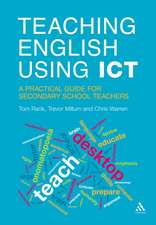Exploration and Meaning Making in the Learning of Science: Innovations in Science Education and Technology, cartea 18
Autor Bernard Zubrowskien Limba Engleză Paperback – 14 mar 2012
| Toate formatele și edițiile | Preț | Express |
|---|---|---|
| Paperback (1) | 947.85 lei 6-8 săpt. | |
| SPRINGER NETHERLANDS – 14 mar 2012 | 947.85 lei 6-8 săpt. | |
| Hardback (1) | 953.97 lei 6-8 săpt. | |
| SPRINGER NETHERLANDS – sep 2009 | 953.97 lei 6-8 săpt. |
Din seria Innovations in Science Education and Technology
- 24%
 Preț: 732.42 lei
Preț: 732.42 lei -
 Preț: 394.87 lei
Preț: 394.87 lei - 15%
 Preț: 636.80 lei
Preț: 636.80 lei -
 Preț: 390.63 lei
Preț: 390.63 lei -
 Preț: 386.22 lei
Preț: 386.22 lei -
 Preț: 381.98 lei
Preț: 381.98 lei -
 Preț: 383.93 lei
Preț: 383.93 lei -
 Preț: 391.02 lei
Preț: 391.02 lei -
 Preț: 397.16 lei
Preț: 397.16 lei - 15%
 Preț: 640.24 lei
Preț: 640.24 lei - 15%
 Preț: 639.41 lei
Preț: 639.41 lei - 18%
 Preț: 962.66 lei
Preț: 962.66 lei -
 Preț: 379.86 lei
Preț: 379.86 lei - 15%
 Preț: 647.59 lei
Preț: 647.59 lei - 15%
 Preț: 649.39 lei
Preț: 649.39 lei -
 Preț: 393.35 lei
Preț: 393.35 lei - 15%
 Preț: 641.53 lei
Preț: 641.53 lei - 18%
 Preț: 900.94 lei
Preț: 900.94 lei - 18%
 Preț: 1000.70 lei
Preț: 1000.70 lei -
 Preț: 386.81 lei
Preț: 386.81 lei -
 Preț: 388.13 lei
Preț: 388.13 lei -
 Preț: 383.93 lei
Preț: 383.93 lei - 15%
 Preț: 585.73 lei
Preț: 585.73 lei -
 Preț: 394.87 lei
Preț: 394.87 lei - 18%
 Preț: 897.33 lei
Preț: 897.33 lei -
 Preț: 392.97 lei
Preț: 392.97 lei
Preț: 947.85 lei
Preț vechi: 1155.91 lei
-18% Nou
Puncte Express: 1422
Preț estimativ în valută:
181.40€ • 188.88$ • 153.30£
181.40€ • 188.88$ • 153.30£
Carte tipărită la comandă
Livrare economică 10-24 martie
Preluare comenzi: 021 569.72.76
Specificații
ISBN-13: 9789400730359
ISBN-10: 9400730357
Pagini: 368
Ilustrații: XXII, 343 p.
Dimensiuni: 155 x 235 x 19 mm
Greutate: 0.51 kg
Ediția:2009
Editura: SPRINGER NETHERLANDS
Colecția Springer
Seria Innovations in Science Education and Technology
Locul publicării:Dordrecht, Netherlands
ISBN-10: 9400730357
Pagini: 368
Ilustrații: XXII, 343 p.
Dimensiuni: 155 x 235 x 19 mm
Greutate: 0.51 kg
Ediția:2009
Editura: SPRINGER NETHERLANDS
Colecția Springer
Seria Innovations in Science Education and Technology
Locul publicării:Dordrecht, Netherlands
Public țintă
ResearchCuprins
Characteristics of a Genetic Approach to Curriculum Design.- A Pedagogical Model For Guided Inquiry.- A Grade 1–9 Curriculum Framework Composed of Archetypical Phenomena and Technological Artifacts.- An Alternative Paradigm as a Basis for a Holistic Approach to Science Education.- The Body Image and Feelings in Science Learning.- Sensory Understanding.- Movement in Explorations, Gestural Representations, and Communication.- Empathy.- Aesthetics in the Learning of Science.- Play and Exploration in the Teaching and Learning of Science.- Play and Variations in Explorations and Representations: The Stereoscopic Principle and Montage in the Design of Science Educational Experiences.- The Role of Metaphor, Models, and Analogies in Science Education.
Textul de pe ultima copertă
This original and unorthodox book summarizes the author’s present thinking about curriculum design and direct work with students. The author draws upon his varied experiences to present a case for the importance of direct engagement with phenomena and materials. He argues that this practice is more than a matter of motivating students to become engaged in inquiry.
The first four chapters lay out different levels of a pedagogical approach and an overall theoretical orientation. The middle chapters focus on what might be called sensory knowledge. These are concerned with the role of different sensory engagement, movement as related to gestural representation and the role of empathy in exploration. The last four chapters are about the role of aesthetic, play, variable exploration and metaphor in their shaping of science education experiences.
Each chapter is introduced with a scenario or case study describing the behavior and talk of elementary or middle school students. The intention of these scenarios is to help the reader stay grounded while considering the more abstract development of research reports and broader philosophical issues.
The first four chapters lay out different levels of a pedagogical approach and an overall theoretical orientation. The middle chapters focus on what might be called sensory knowledge. These are concerned with the role of different sensory engagement, movement as related to gestural representation and the role of empathy in exploration. The last four chapters are about the role of aesthetic, play, variable exploration and metaphor in their shaping of science education experiences.
Each chapter is introduced with a scenario or case study describing the behavior and talk of elementary or middle school students. The intention of these scenarios is to help the reader stay grounded while considering the more abstract development of research reports and broader philosophical issues.
Caracteristici
Addresses issues that are infrequently considered in science education Discusses the relationship between affect and cognition in learning science concepts Gives special attention to the role of aesthetics in science education Gives specific examples of how characteristics of aesthetics and play can be used to structure science curriculum design











